Simulation of Two-Dimensional Images for Ion-Irradiation Induced Change in Lattice Structures and Magnetic States in Oxides by Using Monte Carlo Method
Abstract
:1. Introduction
2. Binomial and Poisson Distribution Functions for the Analysis of the Ion Track Overlapping Effect
3. Monte Carlo Method for Two-Dimensional Imaging of Ion Track Overlapping Effect
4. Results of the Monte Carlo Simulation and the Analysis Using the Poisson Distribution Function
4.1. Amorphization of TiO2 by High Energy Heavy Ion Irradiation
4.2. Lattice Structure Change of ZrO2 by High Energy Heavy Ion Irradiation
4.3. Change in Magnetic States of CeO2 by High Energy Heavy Ion Irradiation
5. Discussion
6. Summary
Author Contributions
Funding
Data Availability Statement
Acknowledgments
Conflicts of Interest
References
- Spohr, R. Ion Tracks and Microtechnology; Bethge, K., Ed.; Vieweg Verlag: Brauschweig, Germany, 1990. [Google Scholar]
- Yamaki, T.; Nuryanthi, N.; Kitamura, A.; Koshikawa, H.; Sawada, S.; Voss, K.-O.; Severin, D.; Trautman, C. Fluoropoly-mer-based nanostructured membranes created by swift-heavy-ion irradiation and their energy and environmental applications. Nucl. Instrum. Methods Phys. Res. Sect. B 2018, 435, 162–168. [Google Scholar] [CrossRef]
- Fleisher, R.L.; Price, P.B.; Walker, R.M. Nuclear Tracks in Solids (Principles & Applications). Nucl. Technol. 1981, 54, 126. [Google Scholar] [CrossRef]
- Toulemonde, M. Nanometric phase transformation of oxide materials under GeV energy heavy ion irradiation. Nucl. Instrum. Methods Phys. Res. Sect. B 1999, 156, 1–11. [Google Scholar] [CrossRef]
- Toulemonde, M.; Assmann, W.; Dufour, C.; Meftah, A.; Studer, F.; Trautmann, C. Experimental Phenomena and Thermal Spike Model Description of Ion Tracks in Amorphisable Inorganic Insulators. Mat. Fys. Medd. 2006, 52, 263–292. [Google Scholar]
- Szenes, G. Information provided by a thermal spike analysis on the microscopic processes of track formation. Nucl. Instrum. Methods Phys. Res. Sect. B 2002, 191, 54–58. [Google Scholar] [CrossRef]
- Fleischer, R.L.; Price, P.B.; Walker, R.M. Ion Explosion Spike Mechanism for Formation of Charged-Particle Tracks in Solids. J. Appl. Phys. 1965, 36, 3645–3652. [Google Scholar] [CrossRef]
- Haff, P.K. Possible new sputtering mechanism in track registering materials. Appl. Phys. Lett. 1976, 29, 473–475. [Google Scholar] [CrossRef]
- Bringa, E. Molecular dynamics simulations of Coulomb explosion. Nucl. Instrum. Methods Phys. Res. Sect. B 2003, 209, 1–8. [Google Scholar] [CrossRef] [Green Version]
- Takaki, S.; Yasuda, K.; Yamamoto, T.; Matsumura, S.; Ishikawa, N. Structure of ion tracks in ceria irradiated with high energy xenon ions. Prog. Nucl. Energy 2016, 92, 306–312. [Google Scholar] [CrossRef]
- Takaki, S.; Yasuda, K.; Yamamoto, T.; Matsumura, S.; Ishikawa, N. Atomic structure of ion tracks in Ceria. Nucl. Instrum. Methods Phys. Res. Sect. B 2014, 326, 140–144. [Google Scholar] [CrossRef]
- Toulemonde, M.; Studer, F. Comparison of the radii of latent tracks induced by hjgh-energy heavy ions in Y3Fe5O12 by HREM, channeling Rutherford backscattering and Mossbauer spectrometry. Philos. Mag. A 1988, 58, 799–808. [Google Scholar] [CrossRef]
- Jozwik-Biala, I.; Jagielski, J.; Thome, L.; Arey, B.; Kovarik, L.; Sattonnay, G.; Debelle, A.; Monnet, I. HRTEM study of track evolution in 120-MeV U irradiated Gd2Ti2O7. Nucl. Instrum. Methods Phys. Res. Sect. B 2012, 286, 258–261. [Google Scholar] [CrossRef]
- Kuroda, N.; Ishikawa, N.; Chimi, Y.; Iwase, A.; Ikeda, H.; Yoshizaki, R.; Kambara, T. Effects of defect morphology on the properties of the vortex system in Bi2Sr2CaCu2O8+δ irradiated with heavy ions. Phys. Rev. B 2001, 63, 224502. [Google Scholar] [CrossRef]
- Ishikawa, N.; Iwase, A.; Chimi, Y.; Michikami, O.; Wakana, H.; Kambara, T. Defect Production Induced by Primary Ionization in Ion-Irradiated Oxide Superconductors. J. Phys. Soc. Jpn. 2000, 69, 3563–3575. [Google Scholar] [CrossRef]
- Benyagoub, A.; Couvreur, F.; Bouffard, S.; Levesque, F.; Dufour, C.; Paumier, E. Phase transformation induced in pure zirconia by high energy heavy ion irradiation. Nucl. Instrum. Methods Phys. Res. Sect. B 2001, 175-177, 417–421. [Google Scholar] [CrossRef]
- Bilgen, S.; Sattonnay, G.; Grygiel, C.; Monnet, I.; Simon, P.; Thomé, L. Phase transformations induced by heavy ion irradiation in Gd2O3: Comparison between ballistic and electronic excitation regimes. Nucl. Instrum. Methods Phys. Res. Sect. B 2018, 435, 12–18. [Google Scholar] [CrossRef]
- Rymzhanov, R.; Medvedev, N.; Volkov, A.; O’Connell, J.; Skuratov, V. Overlap of swift heavy ion tracks in Al2O3. Nucl. Instrum. Methods Phys. Res. Sect. B 2018, 435, 121–125. [Google Scholar] [CrossRef]
- Tracy, C.L.; Lang, M.; Zhang, F.; Trautmann, C.; Ewing, R.C. Phase transformations inLn2O3materials irradiated with swift heavy ions. Phys. Rev. B 2015, 92, 174101. [Google Scholar] [CrossRef] [Green Version]
- Garcia, G.; Rivera, A.; Crespillo, M.; Gordillo, N.; Olivares, J.; Agulló-López, F.; Garcia, N.G. Amorphization kinetics under swift heavy ion irradiation: A cumulative overlapping-track approach. Nucl. Instrum. Methods Phys. Res. Sect. B 2011, 269, 492–497. [Google Scholar] [CrossRef]
- Ishikawa, N.; Yamamoto, S.; Chimi, Y. Structural changes in anatase TiO2 thin films irradiated with high-energy heavy ions. Nucl. Instrum. Methods Phys. Res. Sect. B 2006, 250, 250–253. [Google Scholar] [CrossRef]
- Rath, H.; Dash, B.N.; Benyagoub, A.; Mishra, N.C. Sensitivity of Anatase and Rutile Phases of TiO2 to ion irradiation: Ex-amination of the applicability of Coulomb Explosion and Thermal Spike Models. Sci. Rep. 2018, 8, 11774. [Google Scholar] [CrossRef]
- Ishikawa, N.; Ohhara, K.; Ohta, Y.; Michikami, O. Binomial distribution function for intuitive understanding of fluence de-pendence of non-amorphized ion-track area. Nucl. Instrum. Methods Phys. Res. Sect. B 2010, 268, 3273–3276. [Google Scholar]
- Yamamoto, Y.; Ishikawa, N.; Hori, F.; Iwase, A. Analysis of Ion-Irradiation Induced Lattice Expansion and Ferromagnetic State in CeO2 by Using Poisson Distribution Function. Quantum Beam Sci. 2020, 4, 26. [Google Scholar] [CrossRef]
- Simons, G.; Johnson, N.L. On the Convergence of Binomial to Poisson Distributions. Ann. Math. Stat. 1971, 42, 1735–1736. [Google Scholar] [CrossRef]
- Awazu, K.; Wang, X.; Fujimaki, M.; Komatsubara, T.; Ikeda, T.; Ohki, Y. Structure of latent tracks in rutile single crystal of titanium dioxide induced by swift heavy ions. J. Appl. Phys. 2006, 100, 044308. [Google Scholar] [CrossRef]
- O’Connell, J.; Skuratov, V.; Van Vuuren, A.J.; Saifulin, M.; Akilbekov, A. Near surface latent track morphology of SHI irradiated TiO2. Phys. Stat. Sol. 2016, 253, 2144–2149. [Google Scholar] [CrossRef]
- Benyagoub, A.; Thomé, L. Amorphization mechanisms in ion-bombarded metallic alloys. Phys. Rev. B 1988, 38, 10205–10216. [Google Scholar] [CrossRef] [PubMed]
- Ackland, K.; Coey, J.M.D. Room temperature magnetism in CeO2—A review. Phys. Rep. 2018, 746, 1–39. [Google Scholar] [CrossRef]
- Ohno, H.; Iwase, A.; Matsumura, D.; Nishihata, Y.; Mizuki, J.; Ishikawa, N.; Baba, Y.; Hirao, N.; Sonoda, T.; Kinoshita, M. Study on effects of swift heavy ion irradiation in cerium dioxide using synchrotron radiation X-ray absorption spectroscopy. Nucl. Instrum. Methods Phys. Res. Sect. B 2008, 266, 3013–3017. [Google Scholar] [CrossRef]
- Iwase, A.; Ohno, H.; Ishikawa, N.; Baba, Y.; Hirao, N.; Sonoda, T.; Kinoshita, M. Study on the behavior of oxygen atoms in swift heavy ion irradiated CeO2 by means of synchrotron radiation X-ray photoelectron spectroscopy. Nucl. Instrum. Methods Phys. Res. Sect. B 2009, 267, 969–972. [Google Scholar] [CrossRef] [Green Version]
- Iwasawa, M.; Ohnuma, T.; Chen, Y.; Kaneta, Y.; Geng, H.-Y.; Iwase, A.; Kinoshita, M. First-principles study on cerium ion behavior in irradiated cerium dioxide. J. Nucl. Mater. 2009, 393, 321–327. [Google Scholar] [CrossRef]
- Shimizu, K.; Kosugi, S.; Tahara, Y.; Yasunaga, K.; Kaneta, Y.; Ishikawa, N.; Hori, F.; Matsui, T.; Iwase, A. Change in magnetic properties induced by swift heavy ion irradiation in CeO2. Nucl. Instrum. Methods Phys. Res. Sect. B 2012, 286, 291–294. [Google Scholar] [CrossRef]
- Khayat, O.; Afarideh, H. Heavy Charged Particle Nuclear Track Counting Statistics and Count Loss Estimation in High Density Track Images. IEEE Trans. Nucl. Sci. 2014, 61, 2727–2734. [Google Scholar] [CrossRef]
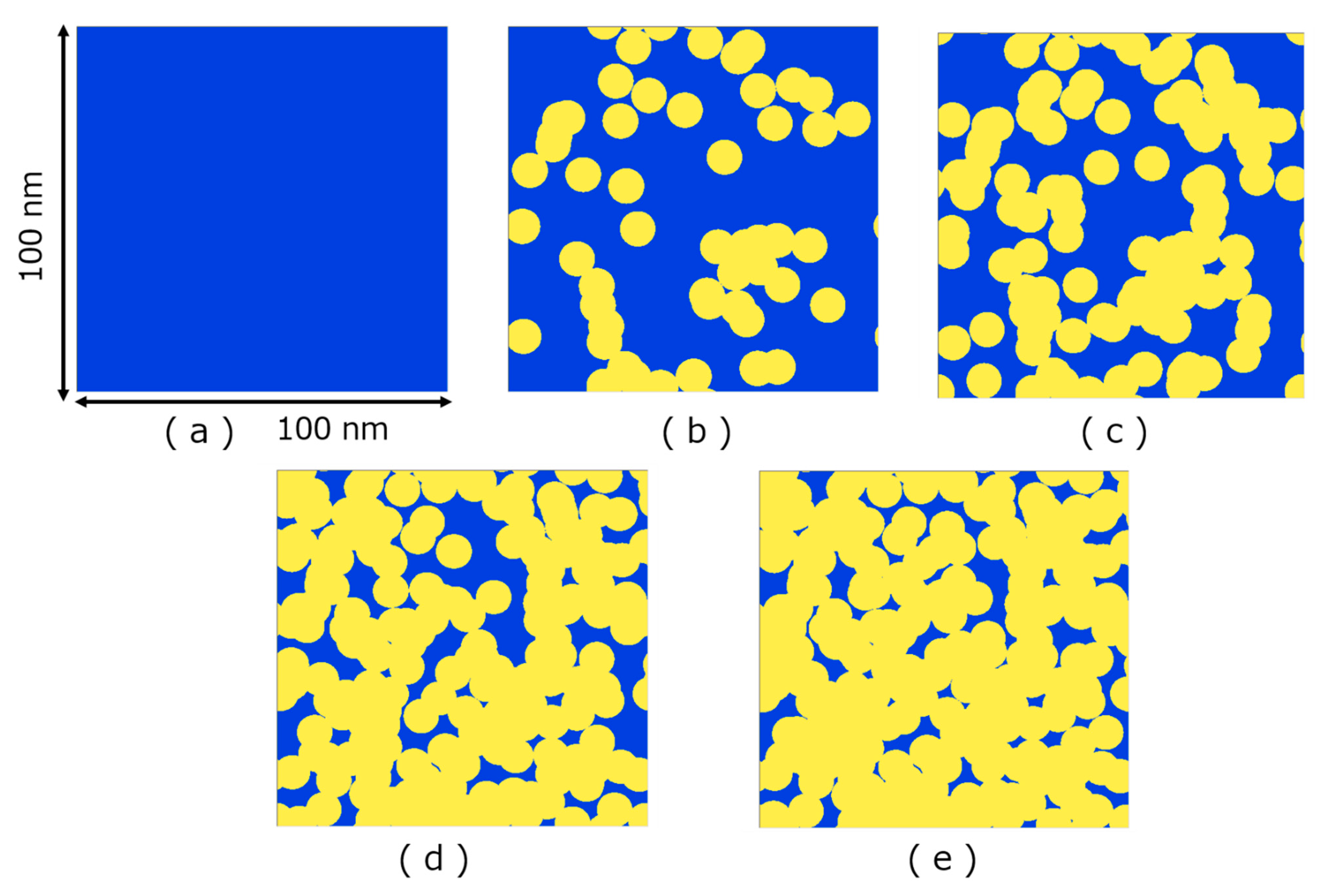

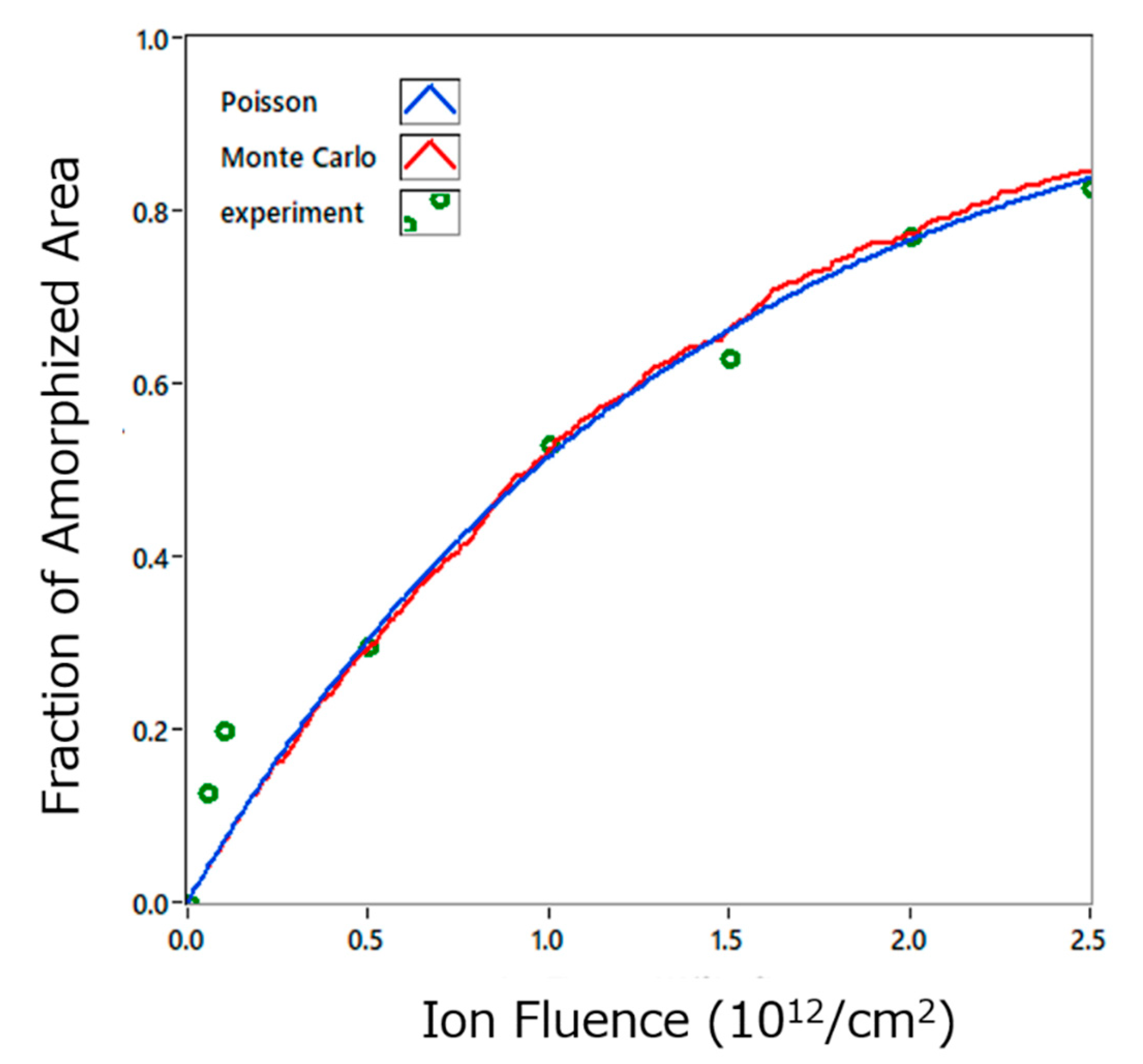
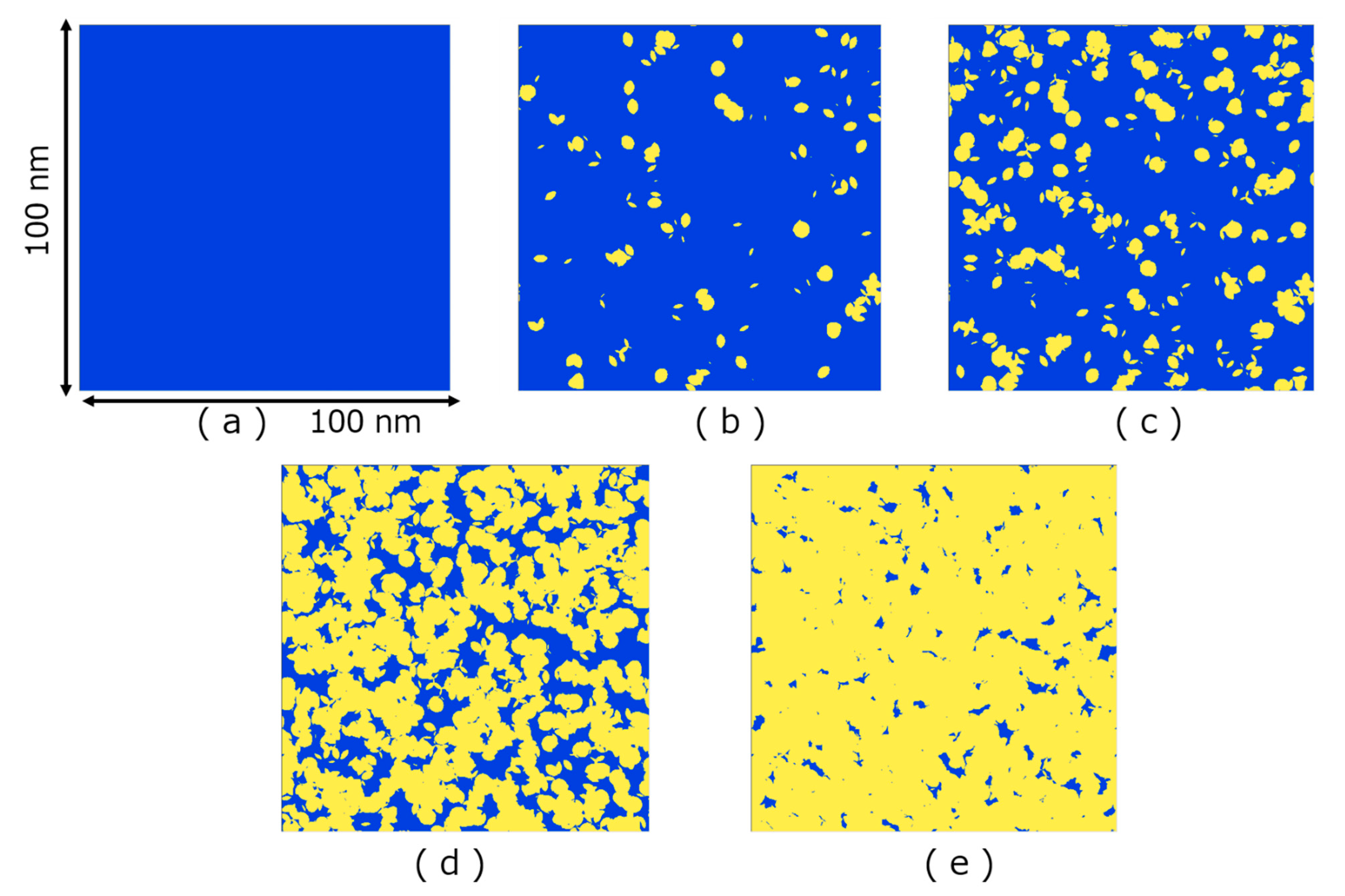
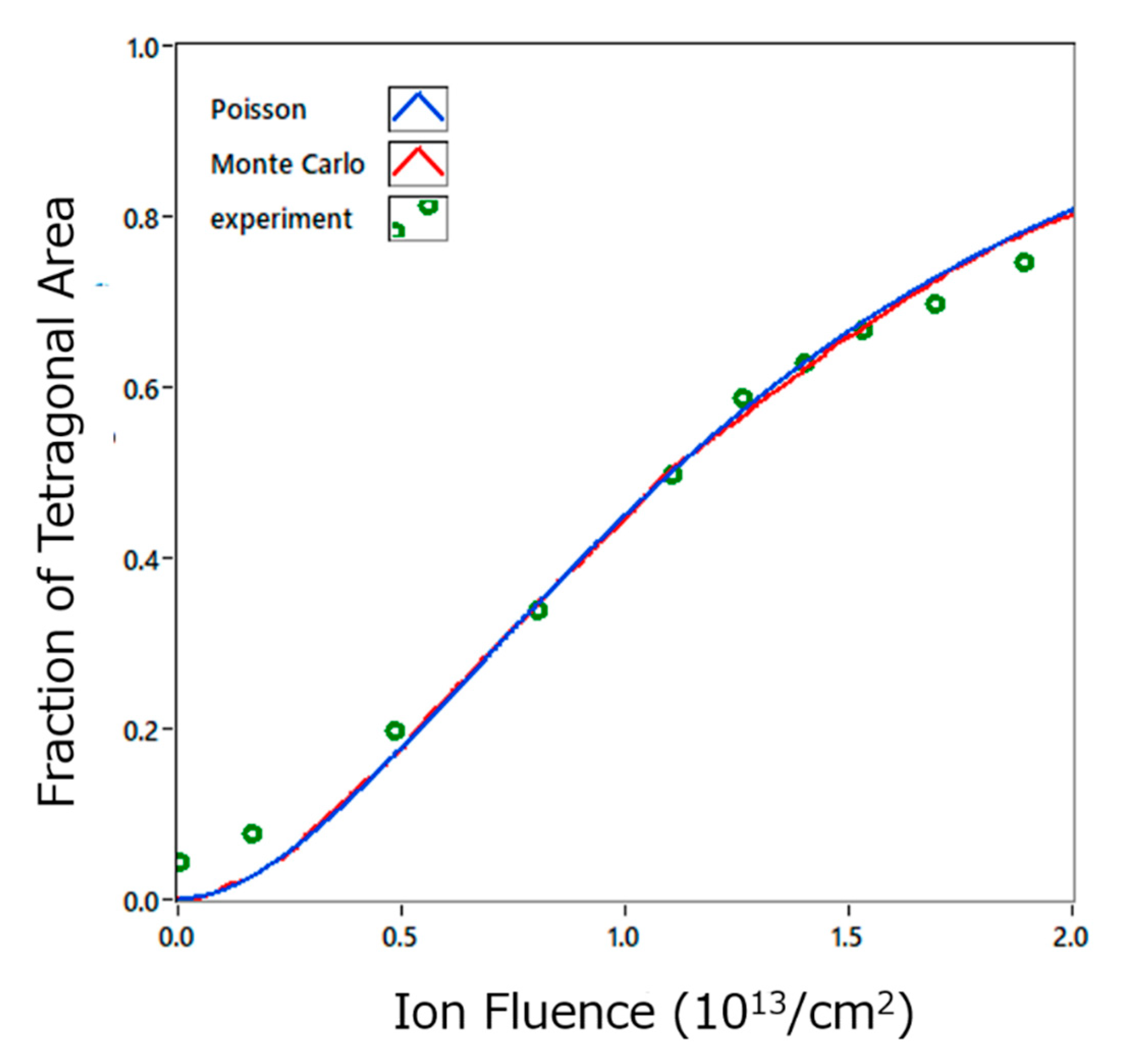
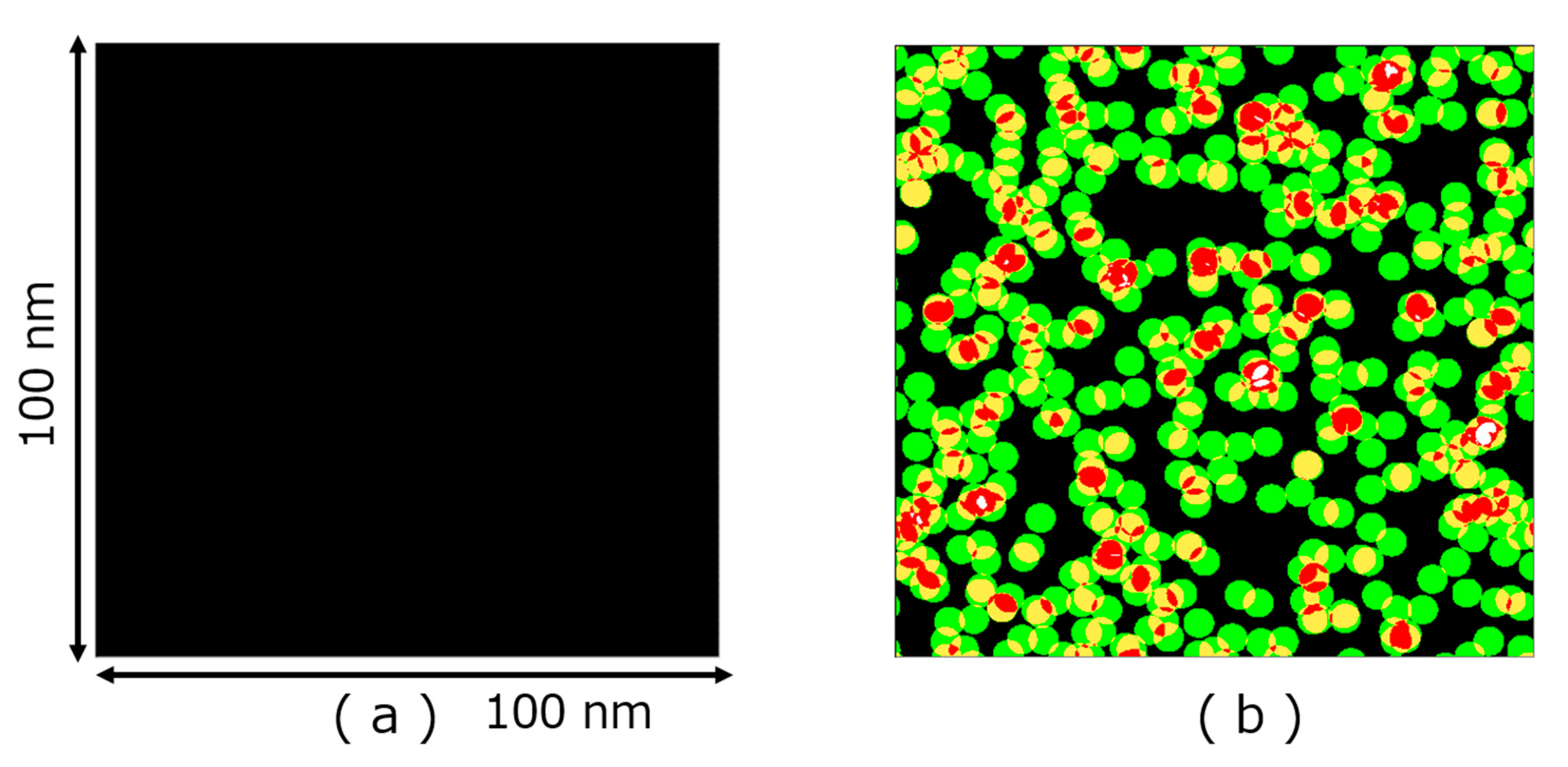
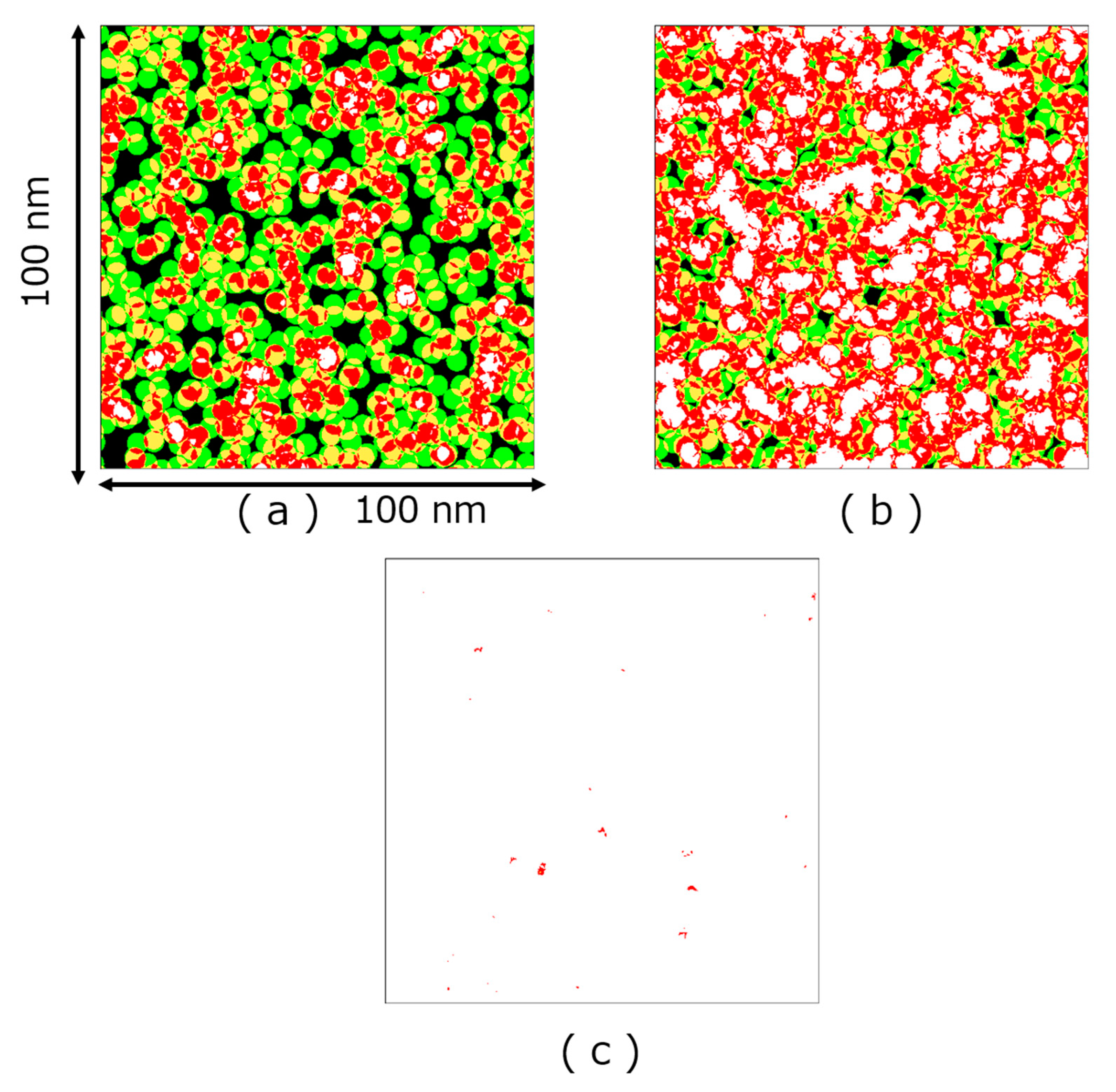

Publisher’s Note: MDPI stays neutral with regard to jurisdictional claims in published maps and institutional affiliations. |
© 2021 by the authors. Licensee MDPI, Basel, Switzerland. This article is an open access article distributed under the terms and conditions of the Creative Commons Attribution (CC BY) license (https://creativecommons.org/licenses/by/4.0/).
Share and Cite
Iwase, A.; Nishio, S. Simulation of Two-Dimensional Images for Ion-Irradiation Induced Change in Lattice Structures and Magnetic States in Oxides by Using Monte Carlo Method. Quantum Beam Sci. 2021, 5, 13. https://0-doi-org.brum.beds.ac.uk/10.3390/qubs5020013
Iwase A, Nishio S. Simulation of Two-Dimensional Images for Ion-Irradiation Induced Change in Lattice Structures and Magnetic States in Oxides by Using Monte Carlo Method. Quantum Beam Science. 2021; 5(2):13. https://0-doi-org.brum.beds.ac.uk/10.3390/qubs5020013
Chicago/Turabian StyleIwase, Akihiro, and Shigeru Nishio. 2021. "Simulation of Two-Dimensional Images for Ion-Irradiation Induced Change in Lattice Structures and Magnetic States in Oxides by Using Monte Carlo Method" Quantum Beam Science 5, no. 2: 13. https://0-doi-org.brum.beds.ac.uk/10.3390/qubs5020013







